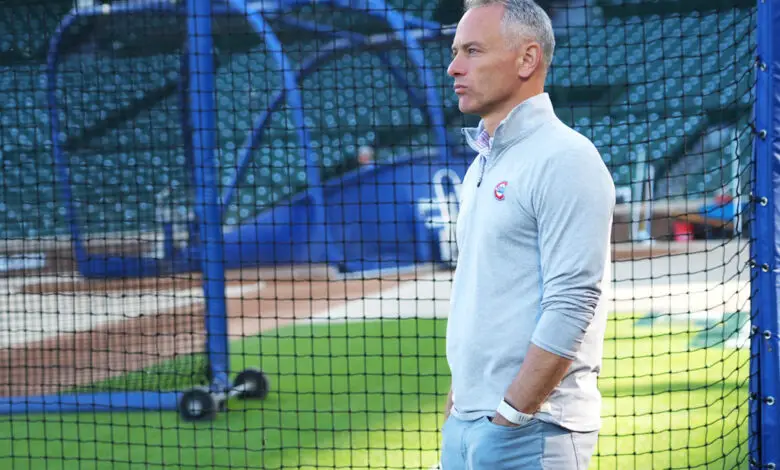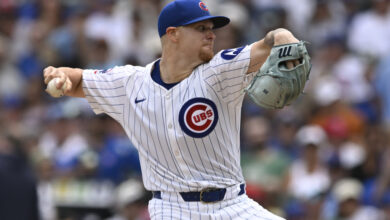
Jed Hoyer Developing Baseball-Themed Purge Script as Massive Roster Turnover Looms
It’s spooky season, which means curling up in front of the TV with whatever particular brand of spine-tingling entertainment tickles your fancy. I’m partial to monsters, myself, though your guilty pleasures may skew more toward psychological thrillers or sci-fi. If I had to guess what Jed Hoyer is watching these days, I’d say he’s into the dystopian action horror of The Purge franchise. Or maybe he’s treating them like research, what with the roster turnover the Cubs are about to experience.
They could see at least 12 members of the 40-man roster culled when the 2025 season officially ends, with others perhaps being cast aside by team decisions. Kyle Tucker will be the most notable loss, though aging bench bats Justin Turner and Carlos Santana will need to be replaced. While I’d wager the club will pick up its $6 million option on Colin Rea to maintain cheap rotation depth, that’s not a guarantee. Things really start to look like a Hoyer move in the bullpen, which is about to be gutted like a jack-o’-lantern.
One of the best relief units in baseball, and the reason the Cubs managed to win more postseason games than the rest of the NL Central combined, could be reduced by seven pitchers. Chief among that group are Brad Keller, Andrew Kittredge, Drew Pomeranz, and Caleb Thielbar, all of whom came up big down the stretch. The quartet of Ryan Brasier, Michael Soroka, Taylor Rogers, and Aaron Civale obviously had much less of an impact, but they will still need to be replaced in some capacity.
Then you have Shōta Imanaga, who some believe the Cubs will let walk by declining their three-year, $57 million club option and then choosing not to extend a qualifying offer should he decline his own option. Though I believe that is both unwise and unlikely, the possibility can’t be ignored.
Reese McGuire and Eli Morgan are both arbitration-eligible players who could be non-tendered, and neither Gavin Hollowell nor Ethan Roberts has a firm grasp on a roster spot. If that all played out, we’d be looking at 17 open spots on the 40-man. The Cubs might choose to protect James Triantos from the Rule 5 Draft by adding him, but righty Brandon Birdsell will not be added since elbow surgery in August will keep teams from selecting him.
It’s a good thing Hoyer will get more than 12 hours to reload the roster, because he’s really got his work cut out for him. The tallest task facing the front office is replacing Tucker’s 4.5 fWAR, a mark that would have been higher had the right fielder not missed a big chunk with his calf injury late in the season. Despite the way public opinion seems to have soured on Tucker, only 25 players ranked higher in WAR. That’s a big hole to fill, and trying to do so with a rookie might not be the best plan.
Rather than trying to pull off a one-for-one replacement, the Cubs may run it back with the idea that they need players to outperform their projections. If Michael Busch makes additional improvements, Seiya Suzuki and Owen Caissie have strong campaigns, and Pete Crow-Armstrong can avoid falling off a cliff again, it’s possible they’ll cobble together enough production to offset most of what Tucker provided. Then again, getting better overall results as a team means getting to something more like the 6+ fWAR Tucker was trending toward through June.
The simplest option would be to make a play to re-sign Tucker in free agency, which means getting comfortable with a deal that could exceed 10 years and $350 million. As big a discount as that is on speculation earlier in the year, it’s still the kind of deal the Cubs have avoided in the past. Hoyer may also want to avoid early opt-outs and a restrictive no-trade clause, making a play at a monster contract even less likely.
Many believe the Cubs will try to right a past wrong by bringing Kyle Schwarber back into the fold, a possibility that bears many of the same challenges as signing Tucker. While Schwarber won’t command as much money, he’s four years older and isn’t nearly as well-rounded in his production. I like the idea of signing him and using young players who’d be displaced as trade chips to fill in the gaps, but I can’t see the Cubs outbidding other teams to make that happen.
Using The Purge movies as a theme isn’t just about the season or what’s going to happen to the roster, it’s about how Hoyer likes to build his teams. Like a series of five films that were made on shoestring budgets ranging from $3-18 million, Hoyer has mastered the art of getting far more value from his pitching acquisitions than expected. I’d go so far as to say he probably finds it to be the most satisfying part of his job. Just look at those names above and think about what they did versus what they should have done.
Keller was a former swingman who had never averaged 95 mph on his fastball, but he morphed into a dominant reliever who sat just over 97 mph. Pomeranz went from not pitching in the majors since 2021 to becoming an integral member of the bullpen who opened Game 5 of the NLDS. Kittredge saved five games after being acquired at the deadline, and Thielbar appeared in a career-high 67 games with a 2.64 ERA as a 38-year-old. That’s a huge aggregate return on several relatively minimal investments.
The problem is that it’ll be very difficult to replicate because some of those pitchers earned the right to ask for a lot more money next season. That shouldn’t be a problem for an organization that may have nine figures to spend this winter, but we know Hoyer is a slave to a value algorithm that has kept him away from multi-year reliever contracts and those that are inflated by bidding.
Add in the fallout from labor strife following the 2026 season and there’s even more reason to believe the Cubs will tread lightly this winter. Hoyer said during his end-of-season press conference that the goal is to keep improving by building on the firm foundation they’ve already established, but the erosion laid out above makes that anything but an easy task.
That’s a big part of why I think they’ll bring Imanaga and Rea back, along with ponying up for Keller. Eliminating a few questions with in-house answers as quickly as possible provides a measure of security and clarity, kind of like having Edwin Hodge and Frank Grillo reprise their roles in a film franchise. We’ve got a little time yet before these decisions have to be made, but you and Chauncey Billups can bet that Hoyer is already laying out myriad scenarios for how he can go about scripting the next pretty good Cubs team.

